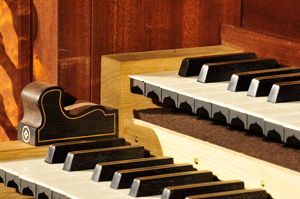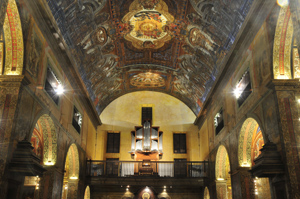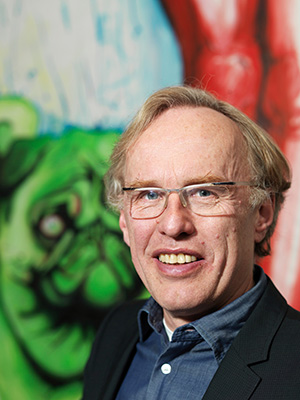 Saturday, 26 October, 9.30, p.m.
Saturday, 26 October, 9.30, p.m.
Igreja de São João Evangelista (Colégio)
Martin Haselböck: organ
In the figure of Jacobus Buus we find the first of a series of Flemish musicians who worked at the Vienna court chapel. After some years of service in Austria, Buus moved to Venice, where his two volumes of Ricercari were published. In their extended and elaborate form, they offer a new, and hitherto unheard, monumental style of organ music
Under the Emperor Leopold I. the Vienna Court Chapel reached its greatest size and importance between 1650 and 1700. Leopold, who also was a gifted composer, attracted major musicians to Austria. Two renowned organists were employed at the same time: Johann Jakob Froberger and Johann Kaspar Kerll. Kerll is represented here by two of his "bizarre" organ compositions: a Battaglia (strangely enough published later under the name of Cabanilles) and a Capriccio imitating the call of the cuckoo.
Georg Muffat, organist at the cathedrals of Salzburg and Passau, is the author of one of the most important collections of organ music in the "mixed style". His Seventh Toccata is a good example of this combination of French and Italian influences: it begins with a French overture, followed by two Italian canzonas, and finishes with a real double fugue.
György Ligeti, one of the great names in 20th century music, wrote several organ pieces which open new doors, at an important crossways of modern music history. The second Etude asks for very fast movements in both hands, so fast that the sound is not distinguished any more by individual notes, but is heard as if it were a series of harmonic chords. The music becomes more and more complex and complicated, and finally cannot be distinguished any more by the listener: les extrèmes se touchent – utmost complexity is transformed into sustained sound. This is the topic of Volumina, the first organ piece written in graphic notation and a masterpiece of a new musical language.
Some of Bach's most popular chorale preludes were originally not written for the instrument but are transcriptions of movements from Cantatas, the so called "Schübler-Chorales", named after their publisher, are some of very few pieces for organ which were printed during the composer’s lifetime.
His Toccata, Adagio and Fugue is one of the masterpieces from his period at the Weimar court. It seems that Bach was interested in experiments in these pieces: contrasting parts are combined to make a new whole, a slow movement in the style of an instrumental concerto is added to the original form of Toccata and Fugue. Whereas the Toccata combines virtuoso passages, a long pedal solo with a concerto-like tutti movement, the Fugue is a masterpiece of hitherto unheard instrumental effects.
Improvisation, an art in earlier times practiced by many instrumentalists, is nowadays almost reserved to jazz musicians and organists. With a theme given during the concert, tonight’s organist will develop its forms and explore its melodic and rhythmic aspects.
Martin Haselböck
Jacobus Buus (ca. 1500-1550)
Ricercare secundi toni
Johann Kaspar Kerll (1627-1693)
Battaglia
Capriccio Cucu
Georg Muffat (1653-1704)
Toccata VII (from Apparatus musico-organisticus)
György Ligeti (1923-2006)
Etude II «Coulée»
Volumina
Johann Sebastian Bach (1685-1750)
Chorale prelude "Wachet auf, ruft uns die Stimme"; BWV 645
Chorale prelude "Kommst du nun Jesu, vom Himmel herunter", BWV 650
Toccata, Adagio and Fugue in C major, BWV 564
Martin Haselböck (1954)
Improvisation on given themes
Participants
|
The Austrian conductor Martin Haselböck hails from a famous family of musicians. Early in his career, following studies in Vienna and Paris and receiving numerous prizes and fellowships, he gained an international reputation as an organ soloist, working with conductors such as Claudio Abbado, Lorin Maazel, Wolfgang Sawallisch, Riccardo Muti and many others. Several composers of our time, including Ernst Krenek, Alfred Schnittke, Cristobal Halffter or Gilbert Amy have written works for Martin Haselböck and dedicated compositions to him. His recordings as an organist have brought him numerous awards, including the Deutscher Schallplattenpreis, the Diapason d'Or and the Hungarian Liszt Prize. He has released over 50 CDs as a soloist, including the important recent release of the complete works for organ by Franz Liszt. Martin Haselböck now enjoys a busy career as a guest conductor with the world’s leading orchestras. He has conducted the Wiener Symphoniker, Leipzig Gewandhaus, Deutsches Symphonie-Orchester Berlin, Dresdner Philharmonie, the Orchestra Giuseppe Verdi Milano, the National Philharmonic Orchestras of Spain, Hungary, Czech Republic, Estonia, Slovakia and Slovenia, Orchestre National de Lyon, Royal Philharmonic Orchestra of Flanders, among many others, and leads an annual cycle of Viennese Classical works with the Hamburg Symphony. In North America his conducting engagements have included concerts with the Los Angeles Philharmonic, Philadelphia Orchestra, Pittsburgh, Washington, San Francisco, Detroit and Toronto Symphony Orchestras, and the Saint Paul Chamber Orchestra. |
Notes about the Organ
 Church of São João Evangelista (Colégio), Funchal
Church of São João Evangelista (Colégio), Funchal
This instrument, with 1586 sounding pipes, is situated in a religious space with certain particularities. As a church typical of those belonging to Jesuit colleges, with a broad nave and quite a gentle acoustic, the organ had to be specially conceived, especially with regard to the measurements of the pipes. Thus all the pipework of the instrument has been specifically tailored to produce a full sound, and each stop produces a timbre with an individual personality, forming part of a harmonic ensemble based more on the sound of fundamentals and less on harmonics. It was also felt to be essential to give the instrument a certain ‘latin’ sonority that would favour performance of ancient music of the Italian, Spanish and Portuguese schools of the 17th and 18th centuries.
Another aspect to be taken into consideration was the need to complement the current range of organs available locally: the new organ responds in an ideal fashion to the performance of works of periods and of technical and artistic requirements that none of the 24 historic instruments of Madeira cater adequately for. It also enhances the range of organs that constitute the island’s heritage by being present in this particular religious space, as well as by existing side by side with other historical instruments. In the decision to build it for this church, not only were the issues of acoustic, aesthetic and liturgical space taken into account, but also the presence there of an important historic instrument which is currently on the list of instruments undergoing restoration.
I Manual - Órgão Principal (C-g’’’)
Flautado aberto de 12 palmos (8’)
Flautado tapado de 12 palmos (8’)
Oitava real (4’)
Tapado de 6 palmos (4’)
Quinzena (2’)
Dezanovena e 22ª
Mistura III
Corneta IV
Trompa de batalha* (mão esquerda / bass)
Clarim* (mão direita / treble)
Fagote* (mão esquerda / bass)
Clarineta* (mão direita / treble)
II Manual - Órgão Positivo (C-g’’’)
Flautado aberto de 12 palmos (8’)
Tapado de 12 palmos (8’)
Flautado aberto de 6 palmos (4’)
Dozena (2 2/3’)
Quinzena (2’)
Dezassetena (1 3/5’)
Dezanovena (1 1/3)
Címbala III
Trompa real (8’)
Pedal (C-f’)
Tapado de 24 palmos (16’)
Bordão de 12 palmos (8’)
Flautado de 6 palmos (4’)
Contrafagote de 24 palmos (16’)
Trompa de 12 palmos (8’)
Couplers
II/I
I/Pedal
II/Pedal
* horizontal reeds
 Martin Haselböck
Martin Haselböck